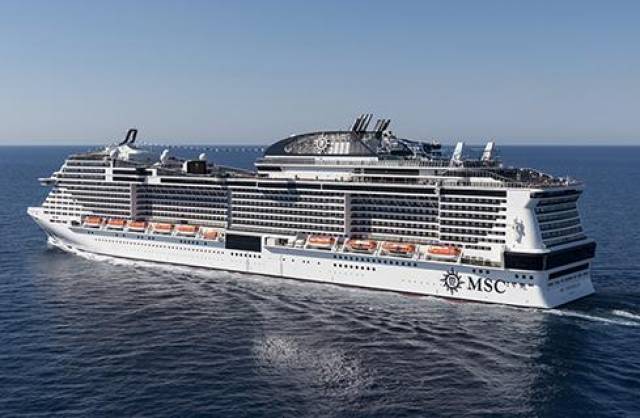#DublinPort - MSC Meraviglia is set to break a record (in passenger capacity) as the largest ever ship to visit an Irish port with a maiden call to Dublin Port in the early hours of tomorrow, writes Jehan Ashmore.
At 19 decks high and towering 65m above the waterline, the 5,700 people-carrying 'Vista' class leadship of Swiss based MSC Cruises is to depart Scotland this evening. The cruiseship currently in Greenock on the Clyde, is the cruiseport for Glasgow.
The massive ship of 171,589 gross registered tonnes, is ranked as the world's fifth largest cruiseship just after Royal Caribbean's 'Oasis'-class vessels. The latest in that series, Symphony of the Seas at 228,081 (grt) is the world's largest cruise ship.
MSC Meraviglia, is scheduled to dock in Dublin Port in the early hours of tomorrow morning at around 03.45 and remain until Saturday late afternoon. The 2,200 cabin ship will then sail overnight to Cork (Cobh) with an arrival this Sunday, as part of a 12-day European itinerary.
Launched last year at the STX French shipyard in Brittany, MSC Meraviglia is the first of MSC Cruises next-generation ship to come into service almost a year ago. The newbuild made a debut last June as part of a €10.5 billion investment plan. At a christening ceremony held in Le Havre, Normandy, actress Sophia Loren, (godmother to all of the MSC fleet) named the cruiseship.
The first season in Northern Europe saw MSC Meraviglia, designed for all seasons, offers world-class entertainment with Cirque du Soleil at Sea, a wide choice of dining options serving a range of international and Mediterranean cuisines. A promenade has an array of bars, restaurants and shops. Among the notable features is the longest LED Sky Screen ever built on a ship.
At 315m MSC Meraviglina is not the longest cruiseship to visit Dublin Port. That title went to a fleetmate the 333m MSC Splendida which as Afloat previously reported made a maiden call to the capital in recent years.
Today, a slightly shorter cruiseship, the 330m Royal Princess, built by Italian shipyard, Fincantieri, arrived in Dublin Port this afternoon carrying more than 3,000 passengers and crew from Cobh. On the call to the capital today, the 'Royal' class ship entered the port astern with the tugs meeting the cruiseship beforehand in Dublin Bay. The precedure of the ship 'reversing' has occured previously, (see story).
The arrival of the Princes Cruises operated giant of 142,714grt, kickstarts a record cruise season for the capital with 151 cruisecalls confirmed for 2018. In total these calls will bring just over 270,000 visitors to the city.
Last month, another giant in the form of US operator, Celebrity Cruises 'Soltice' class Celebrity Eclipse with 2,850 passengers capacity, became the first major cruise ship to call Dublin a “home port”. Again this 19 deck ship of 121,878grt boosts capacity along its 317m length.
The call of Celebrity Eclipse to Dublin Port marks a growing trend towards home-porting. Also the season features 17 further partial turnarounds, where cruise passengers can either start or end their journey in the capital's port.






























































